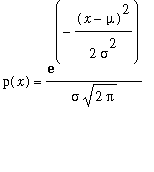MATH 134 -- Intensive Calculus for Science 2
Normal probability densities
March 25, 2002
The normal pdf with mean
![]() and standard deviation
and standard deviation
![]() is defined by
is defined by

> normaldist:=(mu,sigma,x)->exp(-(x-mu)^2/(2*sigma^2))/(sigma*sqrt(2*Pi)):
The value of
![]() gives the "center" of the distribution, and the value of
gives the "center" of the distribution, and the value of
![]() describes
describes
how "spread out" it is around the center. Here are some examples. First,
![]()
> plot(normaldist(0,1,x),x=-4..4,axes=boxed);
![[Maple Plot]](images/Normal7.gif)
Next,
![]() to illustrate what changes as
to illustrate what changes as
![]() increases -- the bigger
increases -- the bigger
![]() is, the more spread-out the density is (and the lower the peak at
is, the more spread-out the density is (and the lower the peak at
![]() is):
is):
> plot({normaldist(1,.2,x),normaldist(1,1,x),normaldist(1,2,x)},x=-3..4,axes=boxed);
![[Maple Plot]](images/Normal12.gif)
On the other hand, fixing
![]() , but increasing
, but increasing
![]() just shifts the graph to the right:
just shifts the graph to the right:
> plot({normaldist(1,1,x),normaldist(2,1,x),normaldist(3,1,x)},x=-3..7,axes=boxed);
![[Maple Plot]](images/Normal15.gif)
For
every
normal density function, the probability Prob(
![]() <=
x <=
<=
x <=
![]() ) is the same:
) is the same:
> Digits:=20;
![]()
> evalf(Int(normaldist(0,1,x),x=0..1));
![]()
> evalf(Int(normaldist(12,.03,x),x=12..12.03));
![]()
(up to the error from Maple's numerical integration routines!) This says: The probability
that a normally distributed random variable is between its mean and its mean plus its
standard deviation is just a bit more than .34 (or 34%).